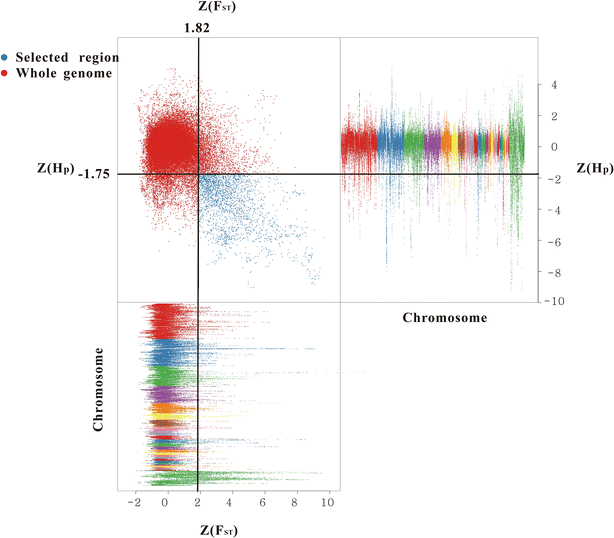Whole-genome resequencing of Xishuangbanna fighting chicken to identify signatures of selection
- PMID: 27565441
- PMCID: PMC5000499
- DOI: 10.1186/s12711-016-0239-4
Whole-genome resequencing of Xishuangbanna fighting chicken to identify signatures of selection
Abstract
Background: Selective breeding for genetic improvement is expected to leave distinctive selection signatures within genomes. The identification of selection signatures can help to elucidate the mechanisms of selection and accelerate genetic improvement. Fighting chickens have undergone extensive artificial selection, resulting in modifications to their morphology, physiology and behavior compared to wild species. Comparing the genomes of fighting chickens and wild species offers a unique opportunity for identifying signatures of artificial selection.
Results: We identified selection signals in 100-kb windows sliding in 10-kb steps by using two approaches: the pooled heterozygosity [Formula: see text] and the fixation index [Formula: see text] between Xishuangbanna fighting chicken (YNLC) and Red Jungle Fowl. A total of 413 candidate genes were found to be putatively under selection in YNLC. These genes were related to traits such as growth, disease resistance, aggressive behavior and energy metabolism, as well as the morphogenesis and homeostasis of many tissues and organs.
Conclusions: This study reveals mechanisms and targets of artificial selection, which will contribute to improve our knowledge about the evolution of fighting chickens and facilitate future quantitative trait loci mapping.
Figures


Comment on
-
Whole-genome resequencing reveals loci under selection during chicken domestication.Nature. 2010 Mar 25;464(7288):587-91. doi: 10.1038/nature08832. Epub 2010 Mar 10. Nature. 2010. PMID: 20220755
References
-
- Zhu W, Li H, Song W, Xu W, Shu J, Han W, et al. The genetic diversity and origin of Chinese game chicken. Avian Biol Res. 2009;2:197–202. doi: 10.3184/175815509X12564806862768. - DOI
Publication types
MeSH terms
LinkOut - more resources
Full Text Sources
Other Literature Sources

